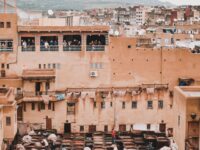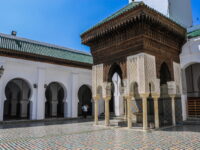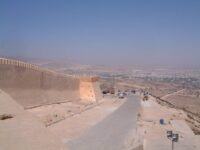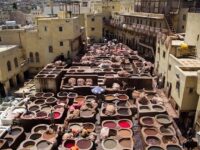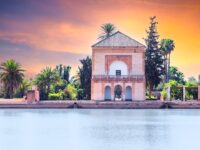History of Casablanca

Casablanca or simply Casa in Arabic Dar El Beïda, the White House; more than 3,000,000 inhabitants.
First city of Morocco and second of Africa behind Cairo by the number of its inhabitants, with nearly 20% of the Moroccan population, Casablanca is first the economic capital.
The country’s leading industrial and commercial center, Morocco’s first port and one of the busiest in Africa, an important stopover point between Europe and Africa or South America, Casablanca collects honorary positions in the statistics that identify “important” cities in today’s world.
The city of Casablanca is a very modern city, it does not have ancient and venerable monuments like the “Imperial Cities” of the interior, but its site has been occupied long ago since prehistoric remains have been found, especially in the west of the city, the remains of what is called “the man of Sidi Abderrahman, Several other deposits have also been unearthed on the very site where the city currently stands, including in the districts of Mers Sultan, Black Rocks, Hermitage and Ain Chok.
History
It is possible, if not probable, that the Phoenicians and then the Carthaginians frequented the area, perhaps building a trading post for exchanges and bartering with the local populations; The place was called Anfa, a name given much later to the hill, now covered with magnificent residential villas, which dominates the city, but the Anfa of those remote times was located on the very site of the present-day Medina, close to the sea; it does not seem that the Romans were interested in the humble hamlet that was then to be the future economic capital of Morocco.
The city was probably a Berber foundation, probably by a chief of the Berrhouatas tribes, who lived in this province, the Tamesna, (now the Chaouïa), and had adopted a heretical doctrine which they defended against the Almoravid and Almohad rulers for two centuries. Before the Xlth century, a rampart was built, erecting the small former village to the rank of city. The revolt was definitively crushed only after the victory of the Almohads over the Berrhouatas and the installation in Atlantic Morocco of Arab tribes of central Maghreb of Hilalian origin (1187).
The city was disputed between the Almohads and the Beni Merinids during the struggles that opposed them and was taken in 1260. The victorious Merinids endowed Anfa with a medersa and a mosque, an ornament of any Muslim city (around 1350).
Chief town of the province of Tamesna, Anfa was a small port that traded with the Portuguese, the Spaniards and the Saadians. It sold mainly wheat (the wheat “anafil”, from the Portuguese anafé, was famous), skins, wool; about “anafé”, some wanted to see the etymology of the name of Anfa, which is not impossible.
The Portuguese occupied several ports on the coast (Sebta in 1415, Ksar Seghir in 1458).
The almost independent city thought it could indulge in piracy, which was its downfall ….
In 1458, a Portuguese punitive expedition of 50 ships and 10,000 men, carefully prepared, attacked the city which was plundered, burned, dismantled and then abandoned by the assailants. They did not return, contrary to an often expressed opinion. Not occupied by the Portuguese, the city was deserted by the Moroccans themselves for three centuries; it is true that all cities at the time experienced a marked decline, due to epidemics and the decline of the population. The legend of a Portuguese citadel on the hill of Anfa destroyed in 1755 by an earthquake is still alive, however; it had to be abandoned. The city remained until the end of the 18th century in the state of ruins frequented by shepherds or sailors in search of fresh water.
Video
Leo the African, who visited it in the early sixteenth century, was moved by the sad sight of the ruins of the city and sincerely believed that this place “had no hope of ever being inhabited again.” ….
Once again, the work of the Alawite dynasty would show what this family of kings was capable of; the great ruler Mohammed Ben Abdallah (the founder of Essaouira) had the ramparts raised and several buildings constructed; he made the city a stronghold intended to watch over the actions of the Portuguese; the name of Anfa having been almost forgotten, the city was named after a kind of whitewashed tower house: It was called “Dar Beida” (White House), a legend says that a pious woman living in the area was called Beida (the white one) and people who wanted to hear edifying words went to her house, they went to “the house of Blanche”, Dar Beida.
It was not until the middle of the 19th century that Casablanca (the Spanish translation of the city’s Arabic name, which the Portuguese called Casablanca) became active again. Three events contributed to this: first, the settlement of foreign merchants, especially French, who came to buy wool and wheat; second, the inauguration of regular shipping lines by several companies, including Paquet (1862); and third, the signing of an Anglo-Moroccan trade treaty.
The city then began to grow in importance. The Algeciras Act of 1906 provided for the construction of a port in Casablanca, and work began in 1907. That same year, incidents broke out between European workers and members of the surrounding tribes; French troops landed and occupied the city, and shortly afterwards the protectorate treaty was signed.
Flower growing in Casablanca and other regions of Morocco
In Casablanca, as everywhere in Morocco, the cultivation of flowers is a real know-how and even a tradition. These plants are appreciated for their beauty and their scent, but they are also used for gastronomy, well-being and in the traditional pharmacopeia. So, if your are looking for flowers in Casablanca, you will easily find specialists who offer different varieties, among which :
- Prickly pear flower: this flower is essential in Morocco. It comes from the prickly pear as its name suggests. It is not used for decoration, but rather as therapeutic and cosmetic products. According to Berber tradition, the flowers of the prickly pear are dried and consumed as an infusion. Several therapeutic virtues are attributed to these plants. They are rich in calcium and potassium, and are very effective against stomach aches, ulcers and inflammations. It should be noted that this plant is now threatened with extinction because of a devastating insect called carmine scale.
- The Damask rose: this rose is cultivated in the south of Morocco, more precisely in the Valley of the roses. It is an area much frequented by tourists, towards the end of the harvest of these plants. These plants are mainly used to produce rose water and cosmetic products. Even if you stay in Casablanca, you will be able to get this plant and its by-products, if you wish.
- Orange blossom: this flower with an unforgettable smell is also typical of Morocco. You will have the opportunity to see these flowers in Casablanca, and to taste local pastries flavored with orange blossom. You will also find this flower in herbal teas, cosmetics, perfumes and essential oils. However, if you want to discover orange blossom plantations in bloom, take a trip to Marrakech in March. You will be greeted by the enchanting scent that permeates the city at this time. You will also have the opportunity to witness the picking of the orange blossoms by the women. The flowers are harvested with long canes that are used to beat the orange branches.
- The Saffron Crocus (Crocus Sativus): this purple flower, certainly very beautiful, is rather cultivated for a spice which it shelters, it is saffron. Still called red gold, it is a quality spice which is sold at very high prices. You will find it abundantly everywhere in Morocco. However, these flowers are cultivated in the mountainous areas of Morocco. This culture is concentrated in Marrakech which is nicknamed the capital of saffron. Saffron is very rich in iron and magnesium, hence its use to nourish and moisturize the skin. It also has therapeutic virtues, in particular to improve digestion.


